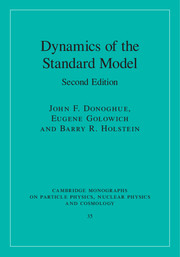Book contents
- Frontmatter
- Dedication
- Contents
- Preface to the second edition
- I Inputs to the Standard Model
- II Interactions of the Standard Model
- III Symmetries and anomalies
- IV Introduction to effective field theory
- V Charged leptons
- VI Neutrinos
- VII Effective field theory for low-energy QCD
- VIII Weak interactions of kaons
- IX Mass mixing and CP violation
- X The N−1c expansion
- XI Phenomenological models
- XII Baryon properties
- XIII Hadron spectroscopy
- XIV Weak interactions of heavy quarks
- XV The Higgs boson
- XVI The electroweak sector
- Appendix A Functional integration
- Appendix B Advanced field-theoretic methods
- Appendix C Useful formulae
- References
- Index
I - Inputs to the Standard Model
- Frontmatter
- Dedication
- Contents
- Preface to the second edition
- I Inputs to the Standard Model
- II Interactions of the Standard Model
- III Symmetries and anomalies
- IV Introduction to effective field theory
- V Charged leptons
- VI Neutrinos
- VII Effective field theory for low-energy QCD
- VIII Weak interactions of kaons
- IX Mass mixing and CP violation
- X The N−1c expansion
- XI Phenomenological models
- XII Baryon properties
- XIII Hadron spectroscopy
- XIV Weak interactions of heavy quarks
- XV The Higgs boson
- XVI The electroweak sector
- Appendix A Functional integration
- Appendix B Advanced field-theoretic methods
- Appendix C Useful formulae
- References
- Index
Summary
This book is about the Standard Model of elementary particle physics. If we set the beginning of the modern era of particle physics in 1947, the year the pion was discovered, then the ensuing years of research have revealed the existence of a consistent, self-contained layer of reality. The energy range which defines this layer of reality extends up to about 1 TeV or, in terms of length, down to distances of order 10−17 cm. The Standard Model is a field-theoretic description of strong and electroweak interactions at these energies. It requires the input of as many as 28 independent parameters. These parameters are not explained by the Standard Model; their presence implies the need for an understanding of Nature at an even deeper level. Nonetheless, processes described by the Standard Model possess a remarkable insulation from signals of such New Physics. Although the strong interactions remain a calculational challenge, the Standard Model (generalized from its original form to include neutrino mass) would appear to have sufficient content to describe all existing data. Thus far, it is a theoretical structure which has worked splendidly.
Quarks and leptons
The Standard Model is an SU(3) × SU(2) × U(1) gauge theory which is spontaneously broken by the Higgs potential. Table I–1 displays mass determinations [RPP 12] of the Z0 and W± gauge bosons, the Higgs boson H0, and the existing mass limit on the photon γ.
- Type
- Chapter
- Information
- Dynamics of the Standard Model , pp. 1 - 27Publisher: Cambridge University PressPrint publication year: 2014



